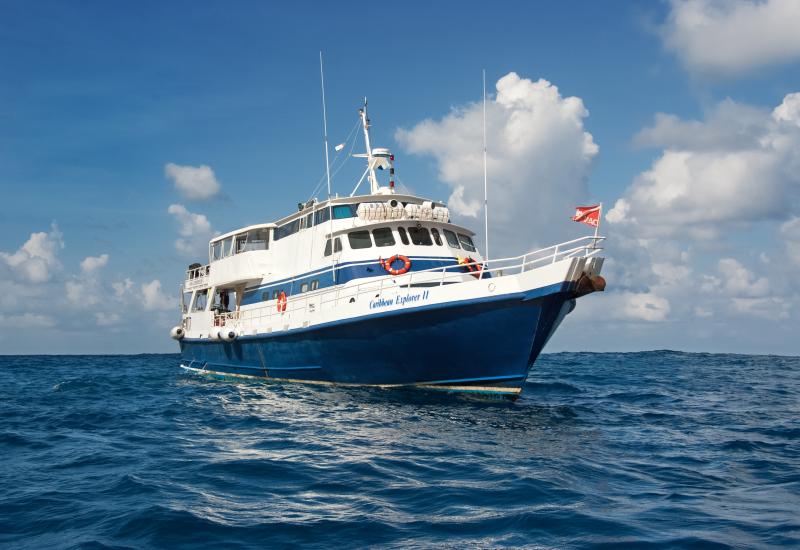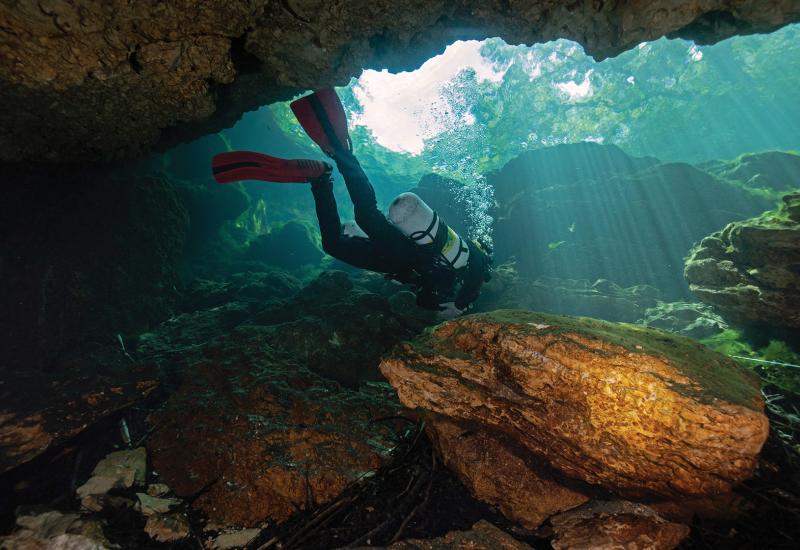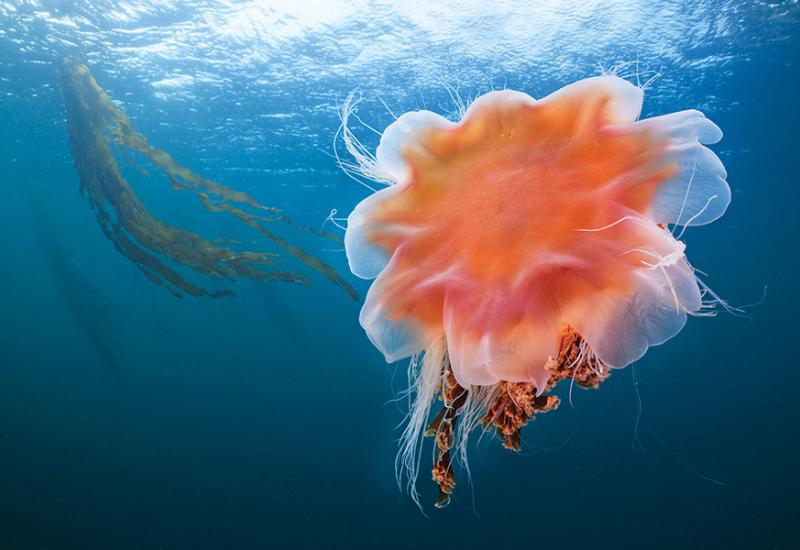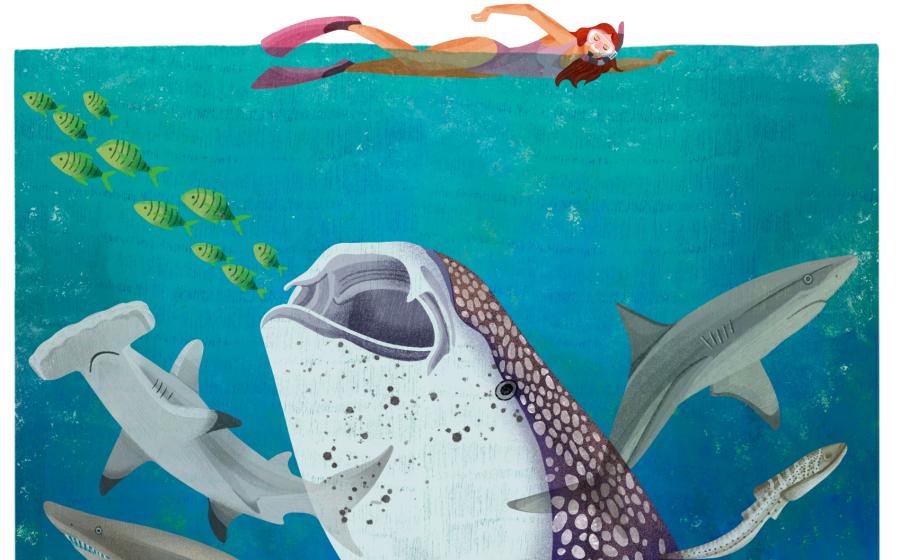Dive Cuba's Silky Seas Aboard the Jardines Aggressor I
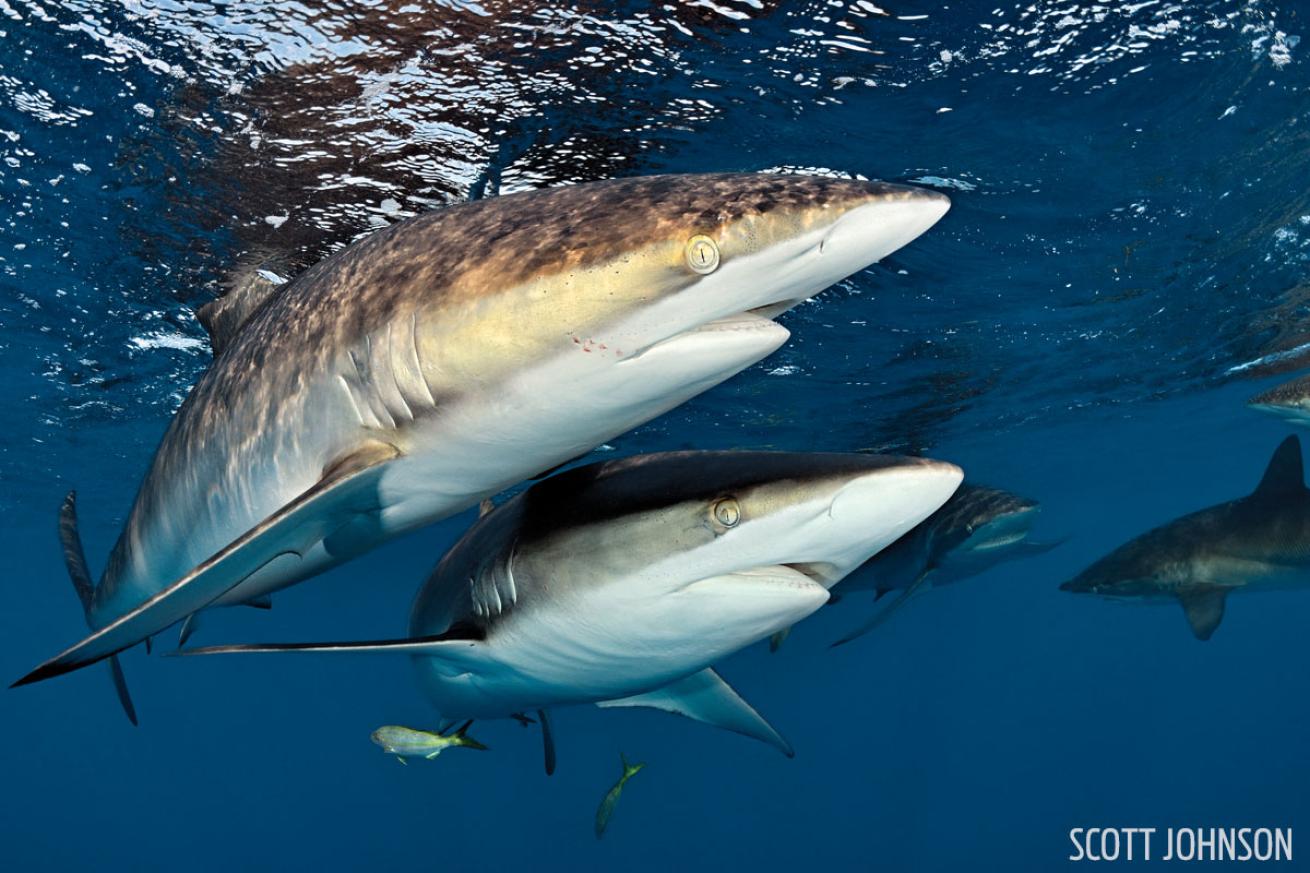
Scott JohnsonSilkies seek the sun at a Gardens of the Queen dive site called Carlos' Corner. Silky sharks are very common in the region.
WHEN TO GO Year-round. Tarpon aggregate for spawning in April/May. Whale sharks are spotted between September and January.
DIVE CONDITIONS 77 to 81 degrees F in winter and 82 to 86 degrees F in summer. For most, these temps translate to a 3 to 5mm wetsuit in winter and a skin to 3 mm wetsuit in summer. The viz is primarily tidal-dependent, with high tides offering 100-plus-feet.
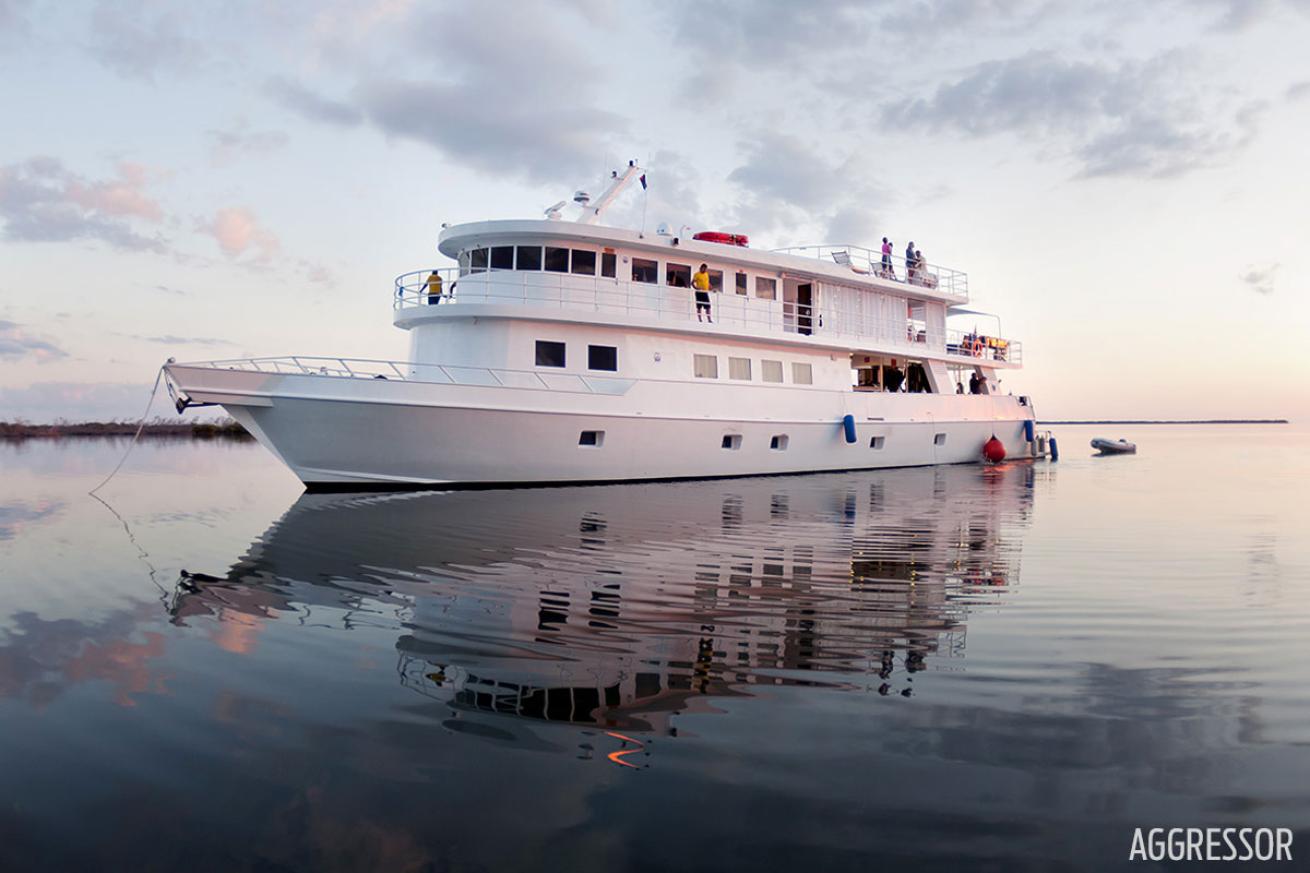
Aggressor Fleet & Dancer FleetJardines Aggressor I.
OPERATOR Aggressor Fleet’s Jardines Aggressor I is a luxury dive yacht 110 feet in length, with a 22-foot beam; it accommodates 20 divers. All staterooms feature air conditioning, en-suite bathroom and storage. U.S. citizens can book through Oceans for Youth Foundation’s People-to-People educational program.
PRICE TAG Starting at $3.999, not including airfare, visa requirements or insurance.
Not that long ago, in oceans not that far away, silky sharks cruised just beneath the surface with seeming impunity. Back in the ’80s and ’90s, at famous dive destinations such as Costa Rica’s Cocos Island and Ecuador’s Galapagos Islands, silkies were so common, it was easy to take them for granted.
Then, the turn of the century wrought a relentless, worldwide barrage of longline fishing that decimated silky populations and those of other animals living high in the water column. Rumors of healthy silkies off Cuba prompted me to investigate the island nation, and ultimately led me to Jardines Aggressor I, Aggressor Fleet’s new dive yacht for U.S. government-sanctioned Cuban dive adventures.
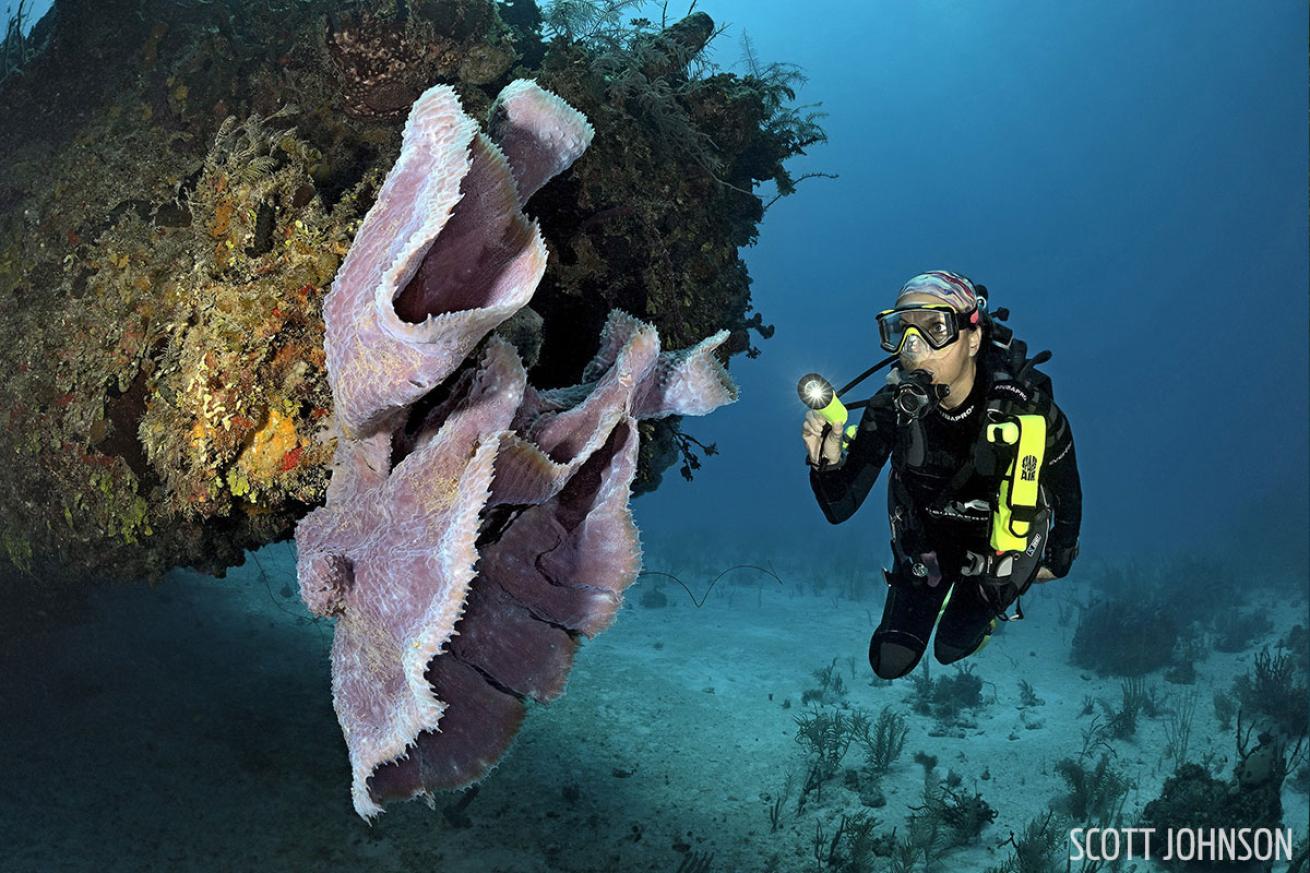
Scott JohnsonA diver inspects a pink vase sponge in Cuba's Gardens of the Queen.
The Republic of Cuba — an archipelago of more than 4,100 islands, islets and keys located roughly 100 miles south of the Florida Keys — has been tantalizing, forbidden fruit for U.S. citizens for the past 50 years. The warming political climate between the former Cold War combatants has opened opportunities for U.S. divers to explore one of the Caribbean’s most successful no-take marine parks: the Gardens of the Queen Marine Protected Area, an 837-square mile center cut of the archipelago. Vigilant education and enforced conservation here have yielded a 35 to 40 percent increase in fish stocks and a spillover effect of 20 percent hikes in adjoining waters. This pristine collection of uninhabited islands, verdurous mangroves, and shallow coral reefs are open to 500 catch-and-release fishermen and 1,000 divers per year. The Aggressor Fleet’s partnership with the Oceans for Youth Foundation’s People-to-People program lets U.S. divers legally book charters on Jardines Aggressor I.
DANCING WITH SHARKS
My quest for Cuban silkies begins with a short 45-minute flight from Miami to Havana and is followed by a “can’t believe I am here” two-night stay in the world’s Yank tank capital. Despite itching to reach the Jardines and get in the water, I thoroughly enjoy my time in the old city. From an informative presentation on the creation and ongoing management of the MPA, by Dr. Julio A. Baisre, Cuba’s Ministry of Fisheries’ director, to meet-and-greets with curious but friendly Cubans, the people-to-people exchanges are rewarding.
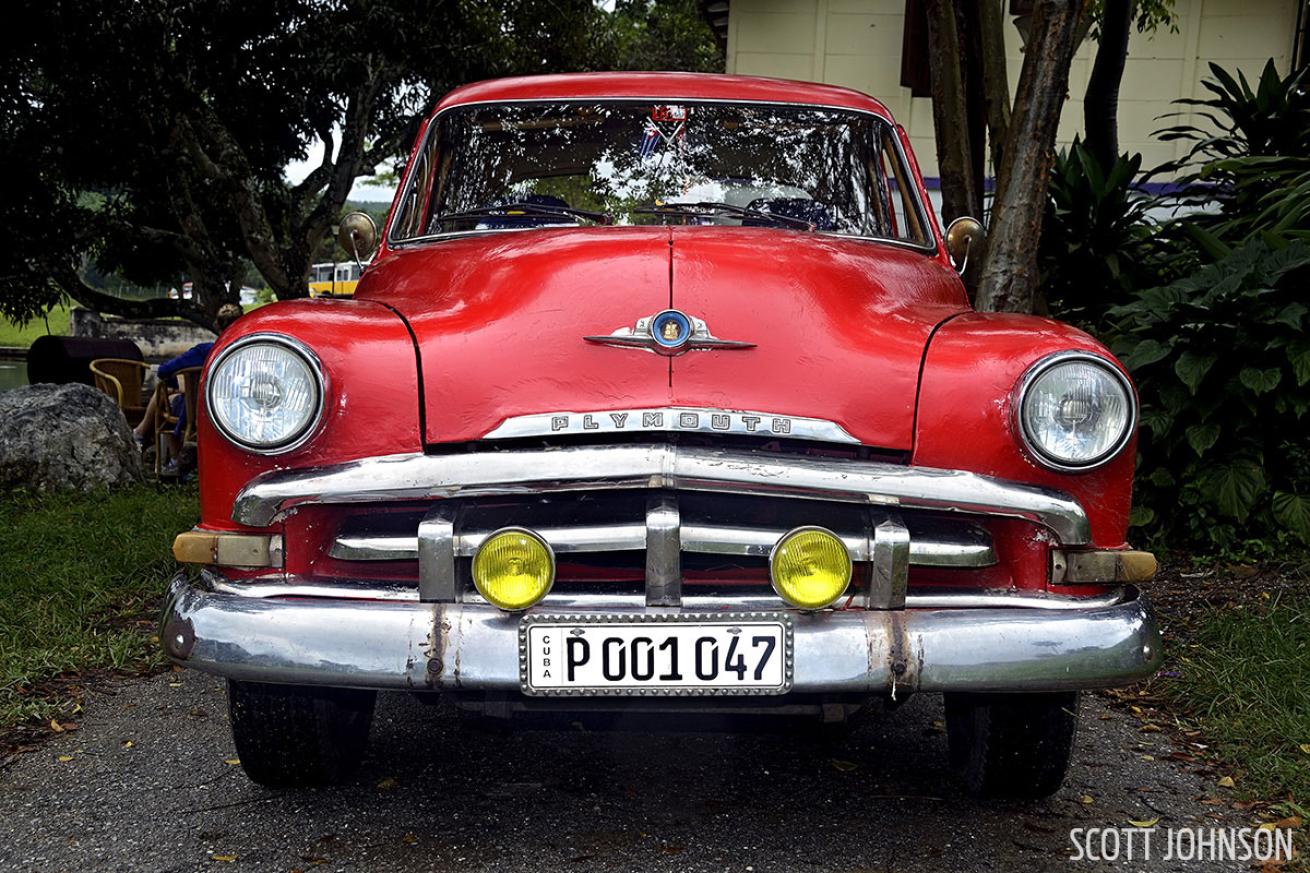
Scott JohnsonOld American cars in Cuba are often referred to as Yank Tanks.
Even the “up before dawn” Saturday morning bus ride to the sleepy fishing village of Jucaro is fascinating. The gently rolling countryside, modest buildings and low-tech vehicles I glimpse through the bus window during the five-hour jaunt suggest that relatively simple lifestyles are the norm for most Cubans. The shiny, new Jardines Aggressor I awaits my group in Jucaro and then carries us on a leisurely four-hour cruise to the MPA.
The crossing gives guests a chance to get acquainted, assemble housings and explore the plush dive yacht. I catch Keith Strange, owner of Paradise Adventures in Napa, California, checking out the hot tub on the upper deck. “How great is this?” he says. “Diving in Cuba and a hot tub to boot! My group is going to love me!” I notice that he isn’t the only one smiling as I wander around the yacht. From guests storing gear in dive lockers on the spacious dive deck to those chatting (and munching) away in the comfy salon, everyone radiates excitement.
As soon as I am introduced to dive guides Noel Lopez and Fausto De Nevi Herrera, I ask if I will actually see silkies during the upcoming week. Lopez, an accomplished photographer whose prints were on display during my visit to Plaza de Armas Square in Old Havana, grins and says: “For sure. Guaranteed.”
“I have worked in Jardines from the beginning,” he says.
“We were fortunate to see three or four silkies here before the park was established. Now, we have to make sure we do not jump on one at the start of a dive.”
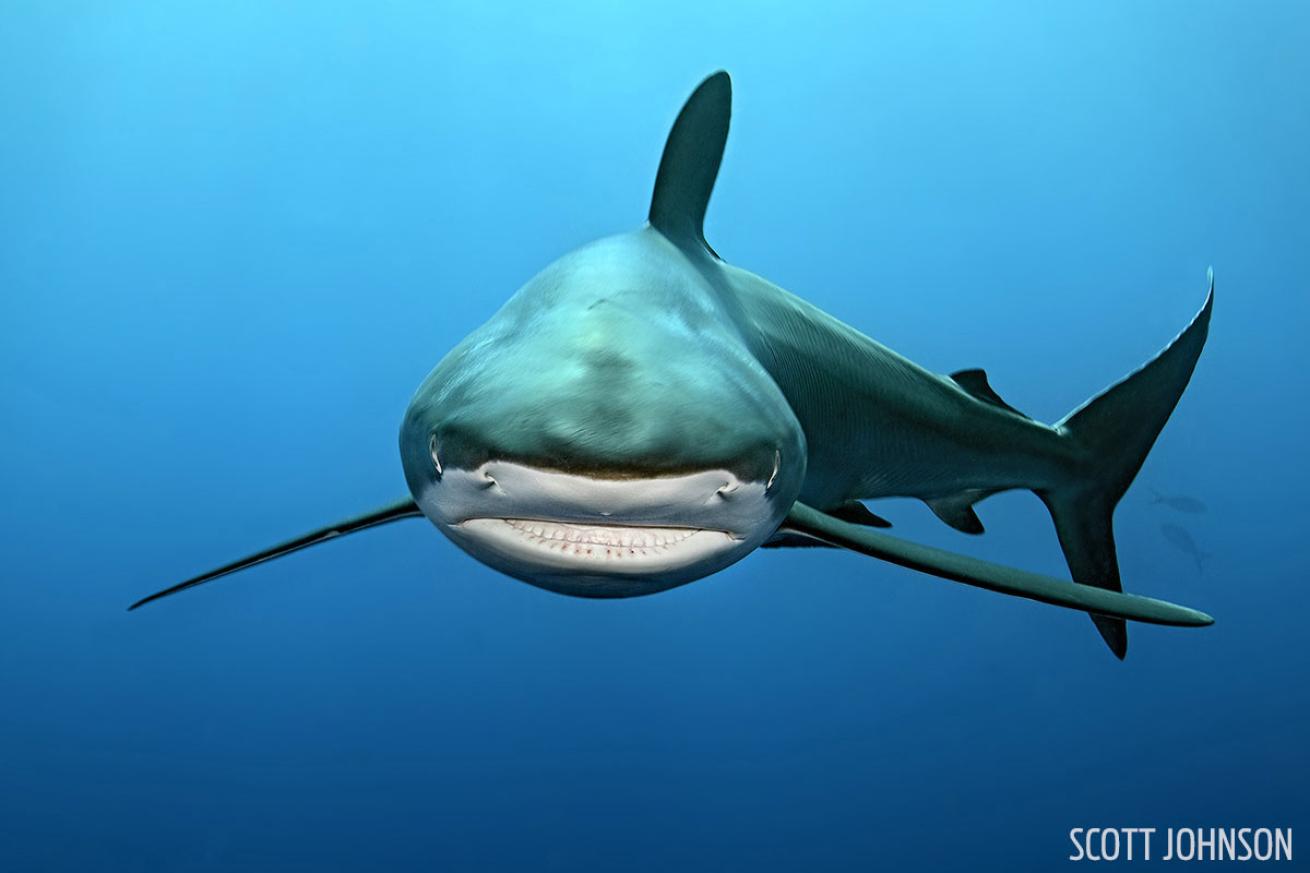
Scott JohnsonSilky shark.
My eyes are open shortly after 5 a.m. as I anticipate the first dive of the trip. When I see Herrera, I ask him when we can try for the silkies. He says: “Now and later. We always find them at Farallon, Pipín and Vicente. Sometimes there are 10. Sometimes there are 20. If there are no tuna to chase, more of the sharks hang out with us.”
True to his word, Herrera takes me and seven other guests to Farallon. Before the skiff is even secured to the mooring buoy, a heart-warming dorsal fin breaks the surface as multiple sleek, bronze shapes start to circle us.
What follows is more than an hour of dancing with silkies from 40 feet to the surface. These beautiful and inquisitive sharks seem to have no appreciation of personal space as they rub against one another and even manage to turn one of my strobes off three times! That’s definitely a first. Sharks have chewed and head-butted my strobes frequently during my career, but no creature without fingers has actually been able to turn them off...until now.
The adults are impressive 8-foot specimens, but the real showstopper is a 2-foot pup that zooms around the group as if it owns the place. The assortment of sizes and ages among the 15 or so sharks that join us is evidence of a robust ecosystem.
WHERE THE WILD THINGS STILL ROAM
Our dives throughout the week prove silkies are not the only species thriving in the MPA. Visits to Black Coral I, Black Coral II, Finca de Pepe, Five Seas and Snapper Head feature muscular Caribbean reef shark escorts. The sharks are ever-present and definitely not shy. They swim around and among schools of blue tangs, blue-striped grunts, chub, creole wrasse and porkfish, like steadfast sentinels patrolling the gardens.
Visibility here is tidal-dependent, which means incoming tides carry clear open-ocean water into the mangroves, and outgoing tides leave me swimming in sediment-laced soup. Fortunately, a wonderful array of macro subjects like arrow blennies, clown crabs and mouthbrooding yellowhead jawfish are local natives.
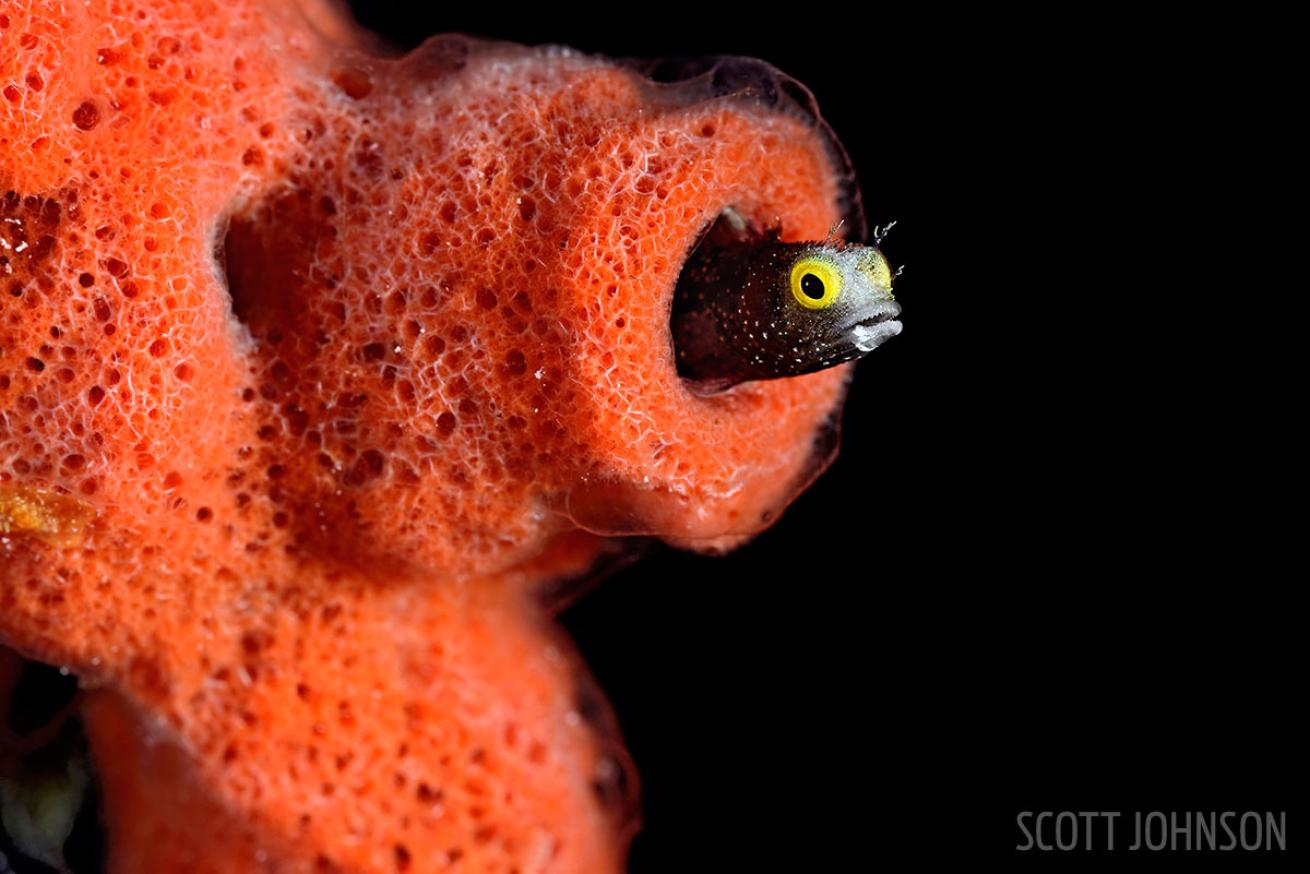
Scott JohnsonSpinyhead blenny.
Even so, it’s always good to expect the unexpected in Jardines. While trying to shoot a spinyhead blenny peeking out of an orange sponge at Octopus Cave, I get the feeling that someone is looking over my shoulder. I turn to find the big, fleshy lips of a gregarious goliath grouper mere inches from my mask. I swear I hear it yell, “Boo!” before I enjoy a bubble-laced laugh.
Diving in the MPA rocks, but the surface intervals — are they still called surface intervals if you are under the surface? — are unreal. Want to get up close and personal with an American crocodile? I certainly do, so Lopez takes me to Croc Channel (La Boca de Piedra Chiquita), secures the skiff, cups his hands to his mustachioed mouth and bellows, “Niño! (Baby!) Venga! (Come — sounds like “bang.”) Venga! Venga!” In no time, a 6-foot specimen emerges from the mangroves, swims over to commune with Papa Lopez, and then patiently poses for photos.
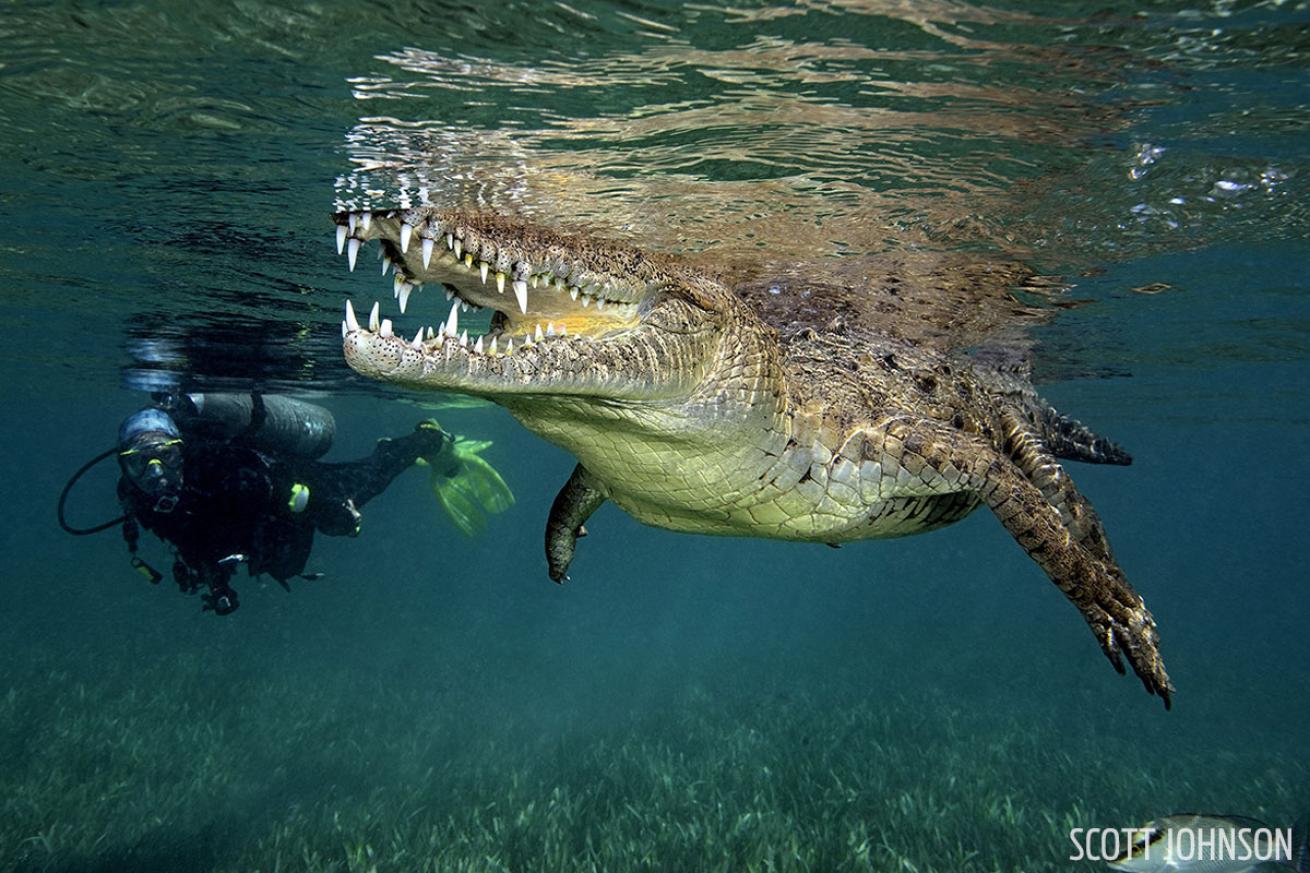
Scott JohnsonWant to get up personal with an American crocodile?
When I ask Herrera if the currents are generally this mild — they have been easy-breezy throughout the week — he explains: “Yes and no. Dive sites, yes. So, you want a strong current? I can show you a strong current.” Curious, but also somewhat concerned by his smirking, nodding face, I man up and squeak, “Show me.”
Between the third and fourth dive on the fourth day, Herrera takes me to Eagle Ray Pass (Boca de Piedras Channel) and says: “The channel is shallow and the tide is changing, so the current is going to be fun. It should take about 15 minutes to go from here to there,” as he points to the other end of the channel. “If you can keep your mask on, you should see many eagle rays.” We jump in and, no freakin’ joke, I feel like I’m going 0 to 60 mph in no time. Sure enough, 15 minutes and 17 eagle rays later, I am on the other side of the channel, screaming: “Again! Again! Let’s do it again!”
We visit the menagerie after the second dive on our very last day to offer bread, fruit and fresh water to chubby jutias, jumping iguanas and persistent hermit crabs.
Feeding the unusual picnickers is a treat, but we too are blessed when Chef Osvaldo and hostess Suli arrive in one of the skiffs holding a “Jardines Pizza Delivery” sign. The ensuing feeding frenzy is joined by all — scales, shells and tails included.
Looking back at the amazing adventures of the past week, there is no doubt the magnificent Gardens of the Queen MPA boasts a thriving and dynamic habitat that is unlike any other I have encountered in the past 30 years. Not only did I find multiple sites to dive and photograph endangered silky sharks, I was given a glimpse of what healthy coral-reef communities probably looked like before I was born. Cuba’s silky seas are truly where the wild things still roam.


